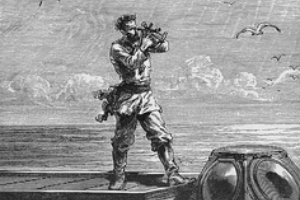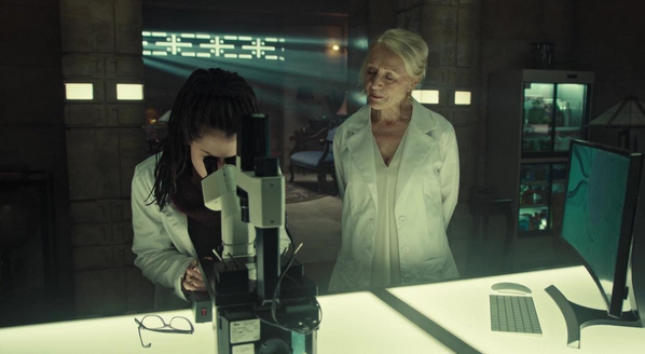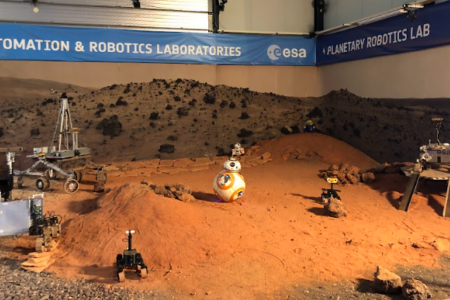It’s a Man’s World: stereotypes of female scientists in films, series and literature
The lights of the movie theatre dim and on the large screen a man wearing a white coat appears. Small round glasses balance on the tip of his nose, his hair looks like it hasn’t been combed in days and in his hand he holds a small bottle with some undefined liquid.
To anyone in the theater it is immediately clear that this man is a scientist. Throughout the film we can see him single-handedly combine at least seven different scientific fields and discover two completely unknown techniques, all in order to become the most powerful man on earth. If the audience has any knowledge of scientific research, they will know that this depiction of a scientist is highly inaccurate. In general, there seems to be quite a large gap between what science looks like in films and what it looks like in real life. For many scientists a white coat isn’t part of their daily outfit, science is a lot more teamwork than is usually shown in cinema and, despite what many films make us believe, scientists, as far as I know, rarely aim for world domination or destruction.
The seven stereotypes
Scientists in films, series and literature can often be categorized into one or more out of seven stereotypes: the evil alchemist; the inhuman researcher, the foolish scientist, the helpless scientist, the mad, bad, dangerous scientist, the adventurer or the noble scientist.1
Most of these stereotypes show a rather negative image of scientists. The evil alchemist only seeks wealth, power or eternal life for himself. The inhuman researcher is so caught up in his research that he is willing to do the most unethical things just to have a scientific breakthrough. The foolish scientist is either unable to or refuses to see that his discoveries can be used by people with bad intentions. The helpless scientist does have good intentions, but is unable to stop his inventions from being used for evil purposes. The worst of all the stereotypes is the mad, bad, dangerous scientist. Similar to the evil alchemist his goal is something like wealth or power, but his actions don’t affect just a small group, they affect the entire world. Sometimes he will even believe that what he is doing is not evil, but the righteous thing to do to cure the world.
Luckily, there are also some less negative stereotypes. In the 19th and 20th century the stereotype of the scientist as an adventurer was very popular. The adventurous scientist mainly uses his scientific discoveries for faster transportation or communication. Think of Captain Nemo from the Jules Verne novels or of Star Wars. The most positive depiction of a researcher is the stereotype of the noble scientist, whose only goal is to use science to create a better world for everyone and who also, at least partly, manages to succeed.


These stereotypes show that scientists can be depicted with a wide range of goals or motivations, but there is one trait almost all scientists in films and series seem to share: they are male. A 2003 study showed that 82% of the scientists in Hollywood films were men.2 This means that the stereotypes for scientists in films, series and literature are mainly based on male characters. So the question arises: which stereotypes exist for female scientists in films and series?
Six stereotypes for female scientists
Let’s first take a look at what the scientific literature has to say about this subject. For female scientists in films, series and literature, six stereotypes have been defined, based on 20th century films: the old maid, the male woman, the naïve expert, the evil plotter, the daughter or assistant and the lonely heroine.3
The old maid stands for a woman that is so caught up in her job as a researcher that it seems as if she is married to it. She is also so rational that she lacks a typical feminine emotionality. The main take-away from such a story is that the character has to choose between being a good scientist and being a good woman. For the male woman there is little focus on her being a woman and she is shown as one of the guys: assertive, practically dressed and with a lifestyle of smoking, drinking and fast food. However, she does seem to have something of a female intuition. It is this female intuition, more than her capacities as a researcher, that helps her solve problems.
The naïve expert is the stereotype of a “proper woman”. Her actual work as a scientist is often not relevant to the film, although she may sometimes provide the other characters with important knowledge. She is always good-looking and often way too young for her profession. Being a young woman, she is also a little naïve, easily trusts the wrong people and can get too emotional at the wrong times. This can get her in trouble, of which only a man can save her. The evil plotter stereotype is the most negative when it comes to personality traits. She is willing to do anything and work together with the most evil masterminds to achieve her own, egocentric goals. This woman is, just like the naïve expert, quite young and extremely handsome, and she is not afraid to use her sexuality to mislead her opponents.
The daughter or assistant is always related to a male scientist, who stands above her. This can either be a boss, a father or a husband. The woman herself may have some scientific qualifications as well, but her main contribution to the story is her emotional and social competence. The lonely heroine is the strongest female character when it comes to the stereotypes of female scientists. She is both a competent and professional researcher, maybe even the best in her field, and a beautiful woman who is aware of her femininity.
This is a man’s world, but it’d be nothing without a woman
As the descriptions of the stereotypes show, stereotypes of female scientists are, when it comes to morals, in general a lot more positive than those of scientists we discussed earlier. Scientists in general are often depicted as immoral beings or people so focused on finding answers to scientific questions that they cause immense damage to their surroundings. Female scientists stereotypically do have a sense of wrong and right. This morality is often ascribed to some sort of female intuition. In this sense the stereotypes for female scientists are more positive.
However, many of the stereotypes assume a mutually exclusive relationship between femininity and scientific skills. The old maid is a perfect scientist, but she doesn’t live up to society’s standard of a woman. The male woman, naïve expert and daughter or assistant may have many scientific qualities, but when it comes down to it, whether they behave like a good woman is much more important. Depending on the stereotype, behaving like a good woman can either be by trusting female intuitions, being caring, loving and emotionally capable or by just being pretty. Moreover, the described stereotypes show that a female scientist in a film or a series almost always has to be considered in relation to a man.
Orphan Black
These stereotypes have been described based on 20th century films, so now let’s have a look at a more modern example: the Canadian Netflix series Orphan Black, in which the majority of portrayed scientists are female. The main theme of the series is using clones to overcome illnesses and obtain eternal life (or at least a very long lifespan). The entire story fits the archetype of the alchemist, who wants to use science to defeat death. The characters fit many of the stereotypes for scientists. There is Cosima Niehaus, who as a noble scientist wants to do research to find a cure for all of the ill clones. Susan Duncan is the helpless scientist, who regrets her contribution to the development of clones. Rachel Duncan shows similarities with the evil alchemist as she only seeks for power for herself. An example of an inhuman researcher from the series is Virginia Coady, who states that anything is allowed as long as it benefits the research.

So the female characters definitely fit the general scientist stereotypes. However, it is much harder to apply the stereotypes for female scientists, probably because the producers chose to show a less stereotypical image of a woman. Still, reproduction and infertility are important themes of the show and those are considered to be typical feminine subjects. So even though the series shows strong, independent female scientists, it still follows some stereotypes.
The times they are a-changin’
Although stereotypes can be very persistent, they do tend to change with time. The development of nuclear bombs caused the stereotype of the helpless or foolish scientist to gain popularity and the race to the moon made the stereotype of the adventurous scientist more common.
Under the influence of feminist movements, female scientists in films and series became more independent and intelligent in the 1960s and they were shown as equally capable as the male scientists.
Sources:
- Haynes, “From Alchemy to Artificial Intelligence”, 244-253
- Weingart, “Of power, maniacs and unethical geniuses,” 282
- Flicker, “Between brains and breasts,” 310-316






0 Comments
Add a comment